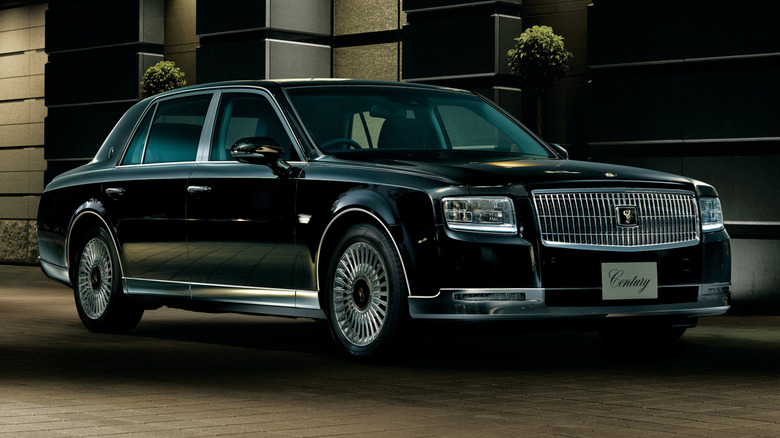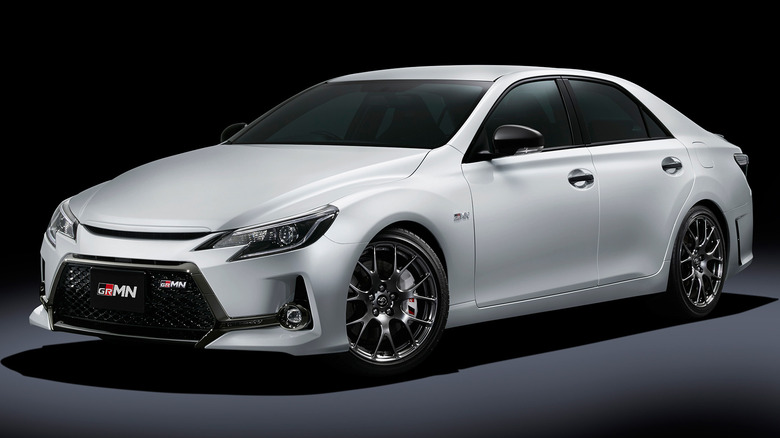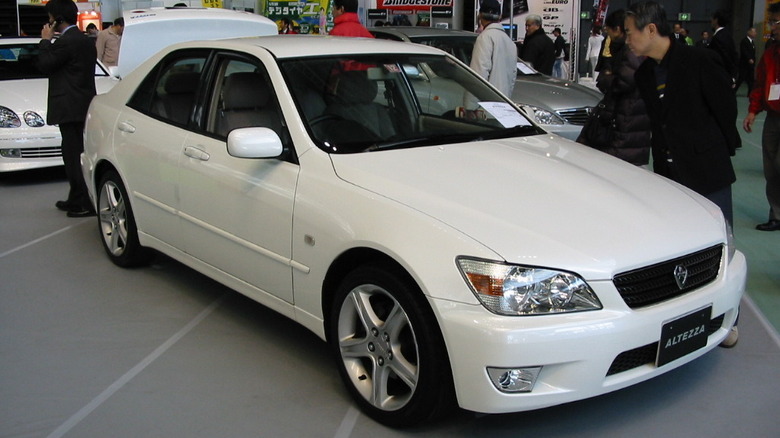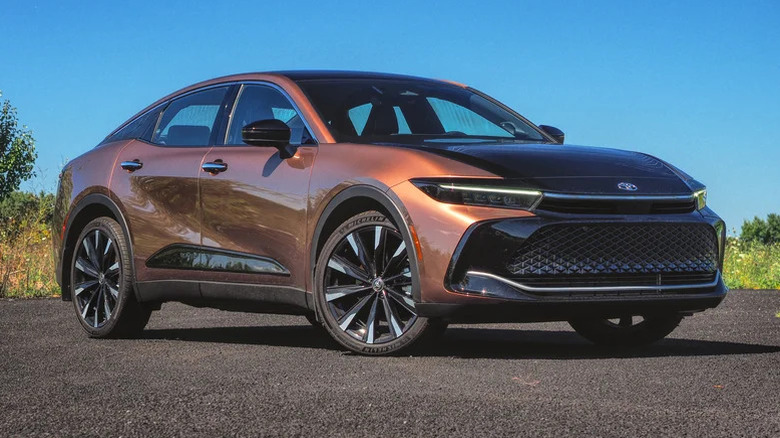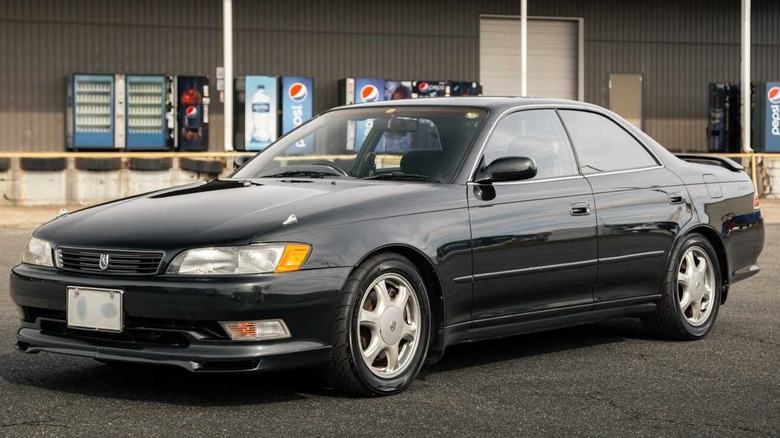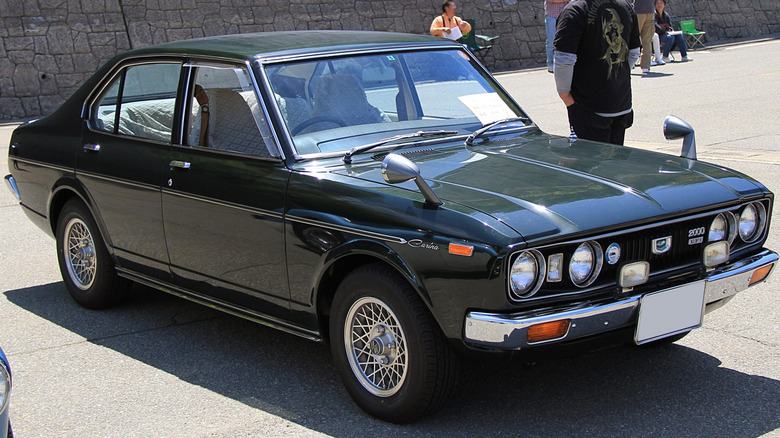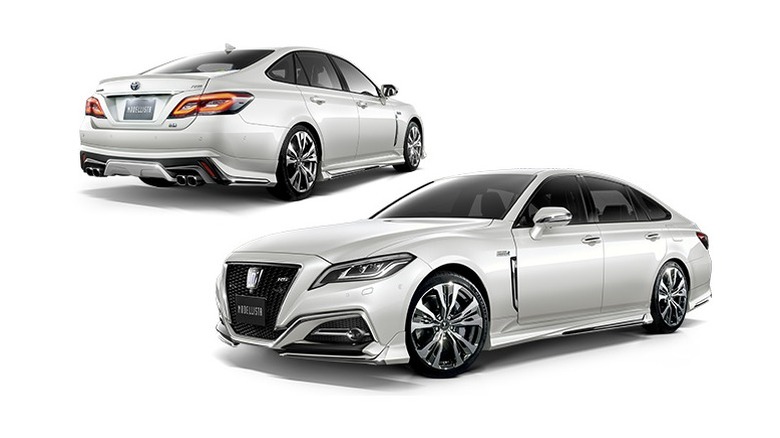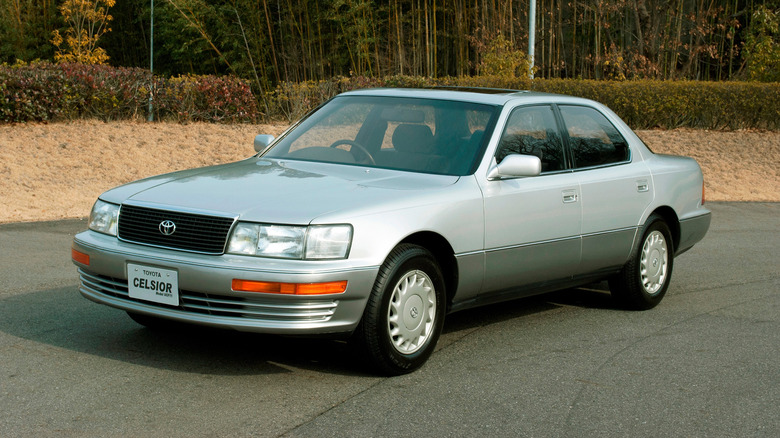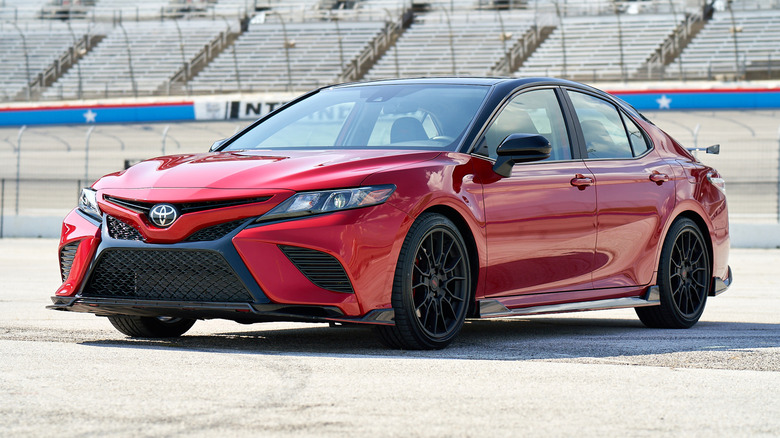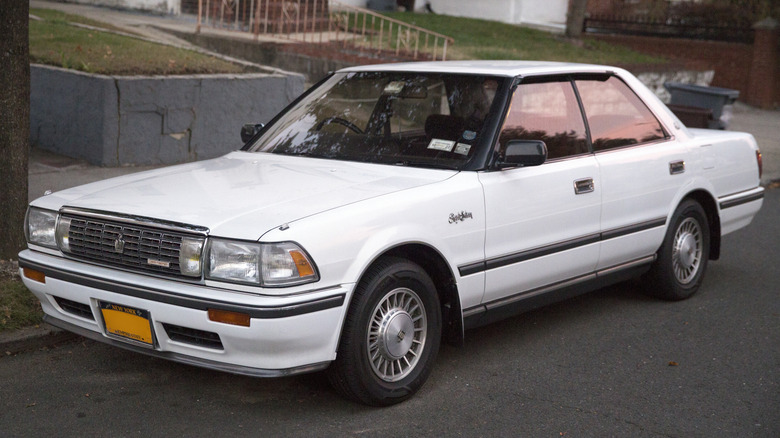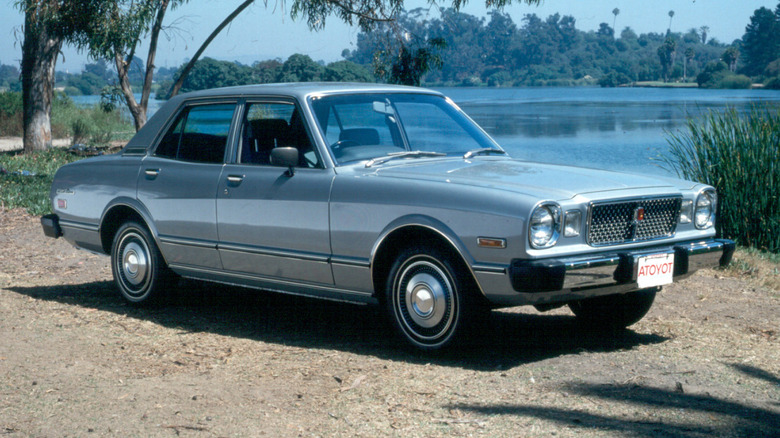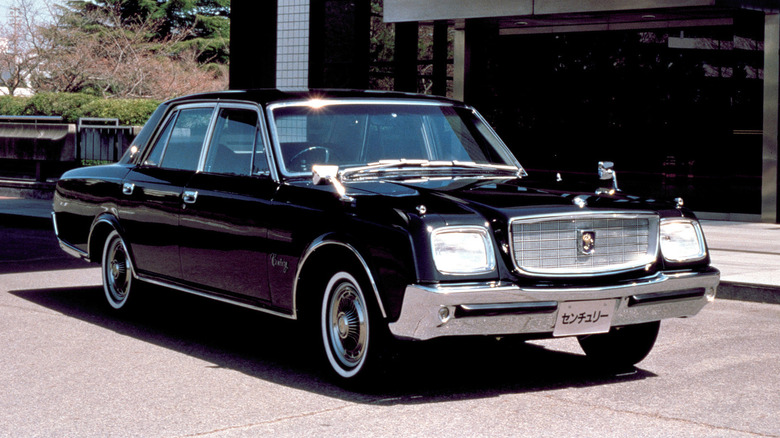13 Of The Best-Looking Toyota Sedans To Ever Make It Off The Production Line
Over the decades, Toyota has designed plenty of handsome, rugged-looking SUVs, as well as plenty of attractive sports cars and brawny trucks. Meanwhile, the brand's sedans have formed the core of the automaker's range for much of that time, but many of them haven't been particularly interesting to look at. A Toyota sedan might be a sensible choice, but it's stereotypically also a bit of a dull one. While it's true that most of the brand's top-selling sedans could most kindly be described as looking unremarkable, there are a few lesser known sedans from Toyota's back catalog that stand out as looking better than the rest.
Many of these sedans were only offered in Japan, and some were only produced in very low numbers. Others were short-lived and mostly forgotten, but we've gone digging through the archives to spotlight them here. From '70s classics to brand new models, we think these 13 Toyota sedans are among the brand's best looking to date. To keep things simple, we've excluded sedans that have only ever been sold under the Lexus brand, although some of our picks here were sold with both Lexus and Toyota badges across different markets.
Toyota Mark X GRMN
Ask most car buyers to picture a stereotypical Toyota sedan and they'll probably picture something like a Camry or Corolla — reliable, sensible, and economical transport, but not all that interesting. However, every so often Toyota allows its engineers to design a sedan that's a little less ordinary, although it sometimes reserves those extraordinary sedans for enthusiasts in its home market.
The Mark X GRMN, unveiled in 2019, is a prime example of what buyers outside of Japan have been missing out on. Toyota took the Mark X, a relatively unremarkable rear-wheel drive JDM sedan in its base form, and kitted it out with a naturally aspirated 3.5L V6 engine with just over 300 horsepower on tap. That power got sent to the ground via a six-speed manual transmission, with unique suspension and a new, drift-ready stability control system rounding out the major mechanical changes.
To complement the performance upgrades, Toyota made sure to give the Mark X GRMN a visual overhaul too. A unique body kit, forged BBS wheels, painted brake calipers and carbon fiber-style accents in the interior all formed part of the package, making the GRMN arguably the best looking Mark X to leave Toyota's production line. It's also one of the rarest, with only 350 examples of the car produced and each one sold through a select network of dealers in Japan.
Toyota Century (3rd generation)
Despite remaining in continuous production for almost six decades, the Toyota Century is only in its third generation. The latest, third-generation Century debuted in 2018, concluding its predecessor's 21-year production. With such long periods in between refreshes, Toyota's design team for the car had immense pressure on their shoulders, since their creation will likely remain the automaker's flagship model for a further two decades. As such, the Century's styling remains remarkably similar to that of the original car that debuted in the late '60s, albeit updated with modern tweaks.
It's undoubtedly one of Toyota's most imposing models, and at first glance, it might be difficult to tell that it's a Toyota at all. There are no Toyota badges on the car; instead, the front of the car displays a phoenix emblem that's hand-engraved by a single craftsman. Each emblem takes six weeks to make.
Even the Century's black paint is meticulously designed to be as visually striking as possible, with each car receiving seven layers of paint in total before leaving the production line. With Nissan discontinuing the President — its only real rival — more than a decade ago, there's simply nothing else like the Century on the market. The third-generation car remains exclusive to the Japanese market, although the second-generation Century was briefly sold in select export markets.
Toyota Altezza
While the rest of the world knew this car as the Lexus IS, in Japan, the sedan was sold as the Toyota Altezza. The reason for this was simple: Toyota couldn't sell it as a Lexus, because it hadn't launched the Lexus brand in Japan. It's the same reason that many other Lexus models from the era have JDM-exclusive Toyota counterparts. Among others, there was the Toyota Harrier, which was sold elsewhere as the Lexus RX, and the Toyota Celsior, which was better known as the Lexus LS400.
The Altezza was Toyota/Lexus' compact sport sedan, and was designed to rival the likes of the BMW 3-Series and Audi A4. Japanese manufacturers didn't really offer sports sedans of that nature at the time, making the Altezza a unique prospect for the Japanese market. Since it was pitched against the Germans, it needed to look the part, and so Toyota gave the car a sleeker, sportier appearance than any of the other Toyota/Lexus models of the time.
Arguably, its styling has aged very well, perhaps even better than some of its German competition. Put an A4 from the late '90s side by side with an Altezza and it's clear to see which car looks sportier, while the car's optional 200 horsepower 3S-GE engine gave it the necessary performance to match those looks.
Toyota Crown (16th generation)
Not everyone will like the look of the latest Toyota Crown. It combines elements of upright crossover styling with the overall proportions of a sedan, and it's available with a bolder choice of paint finishes than most other Toyota models. Love it or loathe it, Toyota deserves credit for pushing the envelope when it comes to modern sedan design. We're in the former camp, and having spent a week with one shortly after the car launched in 2023, we can attest to its ability to grab attention on the road.
It's not usual to see modern car design accused of being boring, with safety regulations and aerodynamic considerations forcing a wider range of cars into a similar shape and style. However, the Crown proves that efficient commuter cars don't have to look dull, and they don't have to be finished entirely in greyscale, either. A 2023 study by iSeeCars found that, on average, cars are only half as colorful as they were 20 years ago, and so the Crown's available color palette of bronze, red, and two-tone paint is a welcome break from the monotony.
Toyota Mark II (7th generation)
The seventh generation or JZX90 Mark II remains a popular car with Japanese enthusiasts, and it isn't just because of its good looks. It was released at the peak of the country's economic bubble, and offered buyers a mix of luxury and performance at a relatively attainable price point. Under the hood of top-spec models sat a 1JZ-GTE engine which produced an officially quoted 280 horsepower. The Mark II was released as part of a trio of related models alongside the Chaser and Cresta, with all three becoming sought-after as drift cars.
The combination of rear-wheel drive, its powerful 1JZ engine, and a manual transmission made the Mark II, in particular, a popular choice. Even today, they remain in high demand with collectors in Japan, although they haven't garnered the same fanbase in overseas markets. It helps, of course, that the seventh-generation Mark II is one of the sleekest-looking cars of its era, especially from the rear, where its one-piece light bar made it instantly distinguishable from other JDM sedans of the era.
Toyota Carina (1st generation)
It isn't as visually striking as many of Toyota's other good-looking sedans, but the first generation of the Carina has a couple of unusual design elements that help it stand out from the crowd. It was marketed as a sedan, but featured styling that Toyota calls "semi-fastback," and it shared parts with the Celica of the era. Another unusual element of the Carina's design was its vertical rectangular taillights, which disappeared upon the launch of the second generation in 1977, seven years after the original.
In addition to domestic sales, the Carina was exported to select European markets. It was especially popular in the UK, where it became the second bestselling Toyota model after the Corolla. Later generations of the car lost the visual charm of the original, morphing into one of the many forgettable sedan designs that Toyota churned out through the '80s and '90s.
Toyota Crown Modellista (15th generation)
The Modellista brand probably won't be a familiar one to most Toyota enthusiasts outside of Japan, as it has only been around since 1997 and doesn't cater to Western export markets. Modellista is Toyota's in-house custom car division, being a wholly-owned subsidiary of the automaker and offering aftermarket-style parts and kits for a range of Toyota and Lexus models. Its current Japanese-market range offers parts for everything from the RAV4 to the Mirai, but arguably one of its best looking models is for the 15th generation Crown sedan.
The 2018 Crown Modellista takes the already handsome sedan and adds unique front, rear, and side skirts, plus various smaller pieces of additional trim and unique 19-inch wheels. The Modellista kits were sold as dealer-installed options through a nationwide network of Toyota dealers, so no production numbers are available. The fifteenth generation Crown remained in production until being replaced by the controversial styled — but arguably equally good-looking — sixteenth generation car. The latter is also available in the U.S., unlike its predecessor.
Toyota Celsior (1st generation)
Alongside the Altezza, the Celsior is another Toyota model that only exists because the Japanese automaker initially didn't launch its Lexus brand in Japan. The Celsior was sold outside of Toyota's home market as the LS400, which was a pioneering luxury car that was key to establishing Lexus as a serious player in the automotive world. It also picked up a reputation for being unwaveringly reliable, with some examples of the car even racking up seven-figure mileage on their odometers.
An important element of the Celsior/LS400's appeal was its appearance, which was as refined as its rivals', yet not imitative. The car's distinctive style signaled that Toyota's newly formed luxury arm meant business, even if in Japan, it still wore the same familiar Toyota badge that could be found on millions of other, more everyday cars across the country.
A reliable indicator of a great design is longevity, particularly if said design remains mostly unchanged across multiple generations of the car. Evidently, Toyota realized that they'd got the Celsior's design exactly right the first time around, as when the second generation of the car arrived in 1994, five years after the first generation launched, there were very few visual changes.
Toyota Camry TRD (XV70)
In many ways, the standard Camry is the opposite of an enthusiasts' car. It prioritises efficiency, reliability, and sensibility at the expense of all else, with no thought given to driving fun. That makes it very appealing to drivers who see their cars as appliances, but it's hardly an ideal starting point for making a fun car. However, that didn't stop Toyota's engineers from creating the Camry TRD, which was available between the 2020 and 2024 model years. As well as being equipped with extras like upgraded brakes and suspension, plus Toyota's trusty V6 engine, the Camry TRD was given a surprisingly comprehensive visual overhaul.
The body kit might be the most noticeable change made to the car, and if you're looking at it from the rear, the additional wing is a pretty glaring indication that this is no ordinary Camry. The 19-inch wheels are also unique to the TRD, and they're accompanied by Bridgestone performance tires. It all leaves the car looking like a proper sports sedan, and arguably the best-looking Camry to ever leave the production line.
Toyota unveiled a new Camry in 2025, and unfortunately, the TRD trim was not carried over. It is unclear whether a new TRD model will appear or if the XV70 Camry TRD ends up as an anomaly in the Camry's history, but let's hope the trim reappears.
Toyota Crown (8th generation)
There's something about an old-school JDM Toyota sedan that none of the brand's modern cars can match, and the eighth generation Toyota Crown arguably embodies that old-school Japanese luxury vibe better than most. It was developed during Japan's bubble era, where carmakers had vast sums of development cash on hand thanks to a rapidly growing economy. As a result, the Crown was more technically advanced than many of its European or American competitors. Unveiled in 1987, the Crown featured air suspension, automatic climate control, and a premium in-car audio system.
The Crown's engine options were equally impressive, with both the 1JZ-GE and 1UZ-FE being available as options during its production run. The 1UZ-FE is one of Toyota's most notable V8 engines thanks to its unrivaled durability, but it only appeared in a handful of Toyota and Lexus models. Combine the Crown's durable engines with its luxurious features and retro looks, and it's easy to see why it continues to be popular with Japanese collectors today.
Toyota Cressida/Mark II (3rd generation)
The first generation Toyota Cressida was only available in the U.S. between 1978 and 1980, and it looked notably different to the automaker's previous sedan offerings. It borrowed styling influences from European sedans and was aimed at export markets including America, where it was more upmarket than the rest of the brand's lineup. The Cressida name was used for overseas sales, but the car was also sold in Japan, where it was marketed as the third generation Mark II.
It certainly isn't the most boundary-pushing sedan design and it's not sporty either, but it's arguably still one of the best looking sedans to roll out of the brand's factories to date. Strangely enough, as well as being sold as a sedan, the Cressida also received a wagon variant complete with old-school fake wood trim, presumably because Toyota thought that was the best way to appeal to American tastes. The woody wagon doesn't look quite as attractive today, but at least the sedan's looks have aged well.
Toyota Century (1st generation)
The original Toyota Century launched in 1967 and remained on sale unchanged for three full decades. The Century name was coined to honor the 100th birthday of Toyota's founder, Sakichi Toyoda, and it was Toyota's first true luxury car. It competed against the Nissan President, but unlike the American-influenced Nissan, the Century was designed to appeal squarely to Japanese tastes from the outset.
Under its hood sat a 3.0-liter V8 engine, which was designed for smoothness rather than all-out power. This was a car designed for its owner to be driven in, rather than to drive, and so it didn't need to be particularly fast. In fact, it only produced around 150 horsepower.
The second-generation Century, unveiled in 1997, made only minimal changes to the overall exterior design of the car. The main changes came under the hood, with the newer car featuring Japan's only V12 engine. This engine was a significant technological improvement over the first-generation car, but in terms of styling, the earlier car arguably has the edge, if nothing else, for its remarkable longevity.
Toyota bZ7
Japan still gets some of its own unique Toyota models, but it isn't the only Asian market that features unique cars from the brand. The Chinese market is now also a hotbed for models that can't be found anywhere else, such as the recently unveiled bZ7. The all-electric sedan is the result of a joint partnership between Toyota and Chinese carmaker GAC, with Toyota claiming that it will combine Toyota's famed reliability with the advanced tech features of the Chinese firm.
The bZ7 has hints of several of Toyota's other recent models, and in particular, bears a resemblance to the latest Prius. For many years, the Prius was considered to be one of the ugliest cars in Toyota's lineup, but the latest generation flips that reputation on its head. We were so impressed with the latest redesign that we even named it one of the brand's best-looking hatchbacks to date. The bZ7 sedan looks just as sleek as the latest Prius hatchback, but unlike the Prius, buyers shouldn't expect to see the bZ7 on American roads anytime soon. For now, it remains a China-only model, and with tariff restrictions unlikely to be lifted anytime soon, it will probably stay that way.
